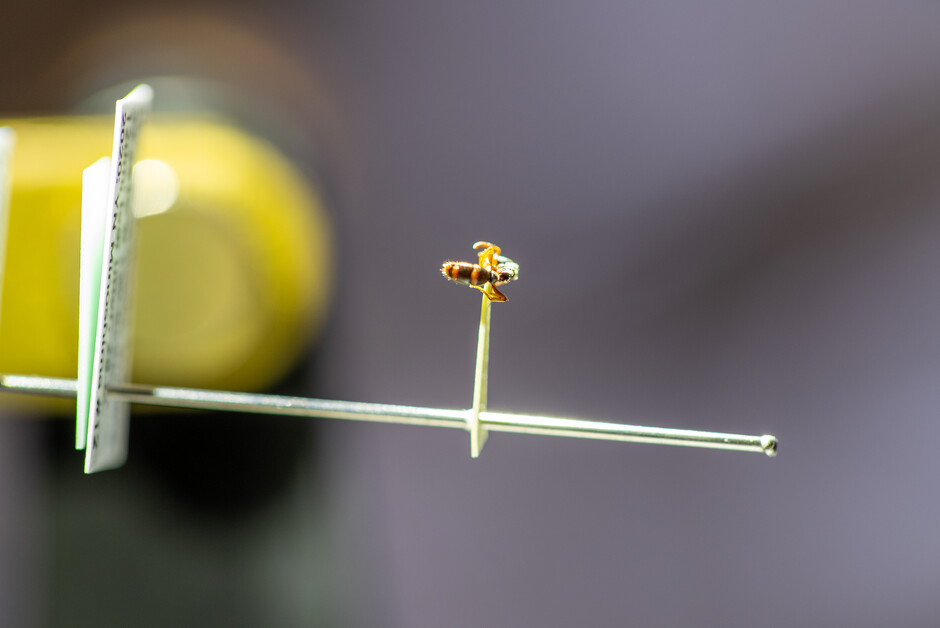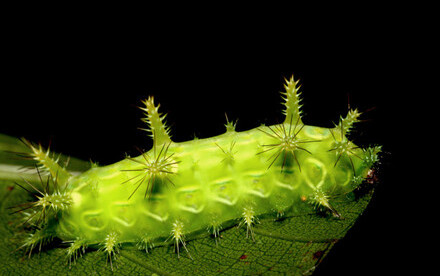11 Mar 2021
Name an Ant initiative - HKU taxonomist brings attention to biodiversity loss by sharing with the public the excitement of discovering new life

An ant from Guénard's collection (Photo by Alex Reshikov)
-9.jpg)
At work in his office. (Photo by Alex Reshikov)
Dr Benoit Guénard is a taxonomist and ecologist at HKU’s Research Division for Ecology & Biodiversity Research at the Faculty of Science. Guénard finds and describes new forms of life, and his team have been making discoveries of new species of ants and other invertebrates in Hong Kong and Macau. In order to make the public aware of the importance of protecting small invertebrates such as ants that are crucial for maintaining healthy ecosystems, Guénard started Name an Ant initiative, where a financial donor has the right to name a new species of ant. Whoever takes part in this initiative will join Harrison Ford and Barack Obama, who both had ant species named after them in recognition to their contribution to protecting the environment.
“You probably read in the news – a craft that cost 2,7 billion dollars has just been sent to Mars to seek life. This is great, but as someone who works on biodiversity, I can tell you that 80% of life on this planet is estimated to be unknown. Even in Hong Kong there are a lot of species to discover!” says Guénard.
Since his arrival in Hong Kong in 2014, Guénard and his students have been discovering and describing new life - 9 new species of ants, 3 species of flies and 3 species of wasps – all new to science, all of them found here in Hong Kong. In the much smaller, far less wild Macau, Guenard’s team described 2 new species of ants. In 2019, the discovery of three new ant species by Guénard’s team made headlines.
“We don’t need to go to Mars to find new life. If I scoop up some leaf litter just here”, Guénard points at a green space on campus, “It is likely to harbour new species - ants, pseudoscorpions, springtails, mites.” One of the new ant species Guénard described, was found “right here, 200 metres from HKU’s plaza”.
Why are there so many undiscovered species right under our noses, in the middle of Hong Kong’s urban sprawl?
“The problem is that nobody looks for them”, says Guénard, explaining that the attention of the public, the scientists and the conservationists often focuses on larger species. Small land arthropods, a group that includes insects, spiders, mites, millipedes and centipedes, remain “below the radar.”
But, he says, land arthropods account for 80% of the world’s biodiversity. These small animals are extremely important – they are essential for ecosystem functioning and must be protected.
Ants are especially important. Thousands of species of plants rely on ants for seed dispersal and ants are also indispensable soil engineers. They enrich the soil by burying vast quantities of organic matter inside it, and by digging their nests, ants maintain the turnover of organic matter in the soil, ensuring that it stays fertile and can support other life. On his website, Guénard quotes Harvard professor Edward O. Wilson who called ants “the little things that run the world”.
In Hong Kong these ecosystem engineers are directly threatened by land development and must be protected. But before protecting a species, we must first name it.
“We need to know how to distinguish them and give them names. Once we give them names, we can start studying them - what do they do? Why are they important, and to what extent? How are they connected together in the ecosystem?”
Scientists say that we are now in the middle of the sixth mass extinction crisis. Guénard quotes a 2015 study that estimates that we may have already lost 7% of the planet’s species – approximately 130,000 in total, far more than previously thought. The same study warns that land invertebrates are under-represented in such estimates, despite them representing the bulk of the world’s biodiversity.
The result is that, not only do we not know how many species of ants and spiders we have already lost, invertebrate species are going extinct without having been described first -ecosystems are losing their vital working parts without people ever knowing what they are.
One of the reasons why discovery and naming of invertebrate species cannot keep up with the rate of extinctions, explains Guénard, is that taxonomy – the discipline of describing and classifying living organisms, is often seen as unexciting and tedious by the biologists and the public.
Guénard tries to break this stereotype by involving both undergraduate students and the public in taxonomy, and he does so by sharing with them the excitement of discovery of new life.
“I try to engage the undergraduate students – the young biologists. They can leave their first mark in science by describing a new species!”
Another incentive is that the students can take part in the official naming of the new species, leaving a permanent record in science.
“I give them the choice how to name the species - sometimes we call the species after other ant biologists. Unfortunately, one of my colleagues passed away last fall, we named one new species after him.” Guénard’s team also named an ant species after Lantau Island, where it was discovered - Strumigenys lantaui.
In 2018 Guénard came up with Name an Ant initiative. Donors can decide on a name of a new species of ant that Guénard’s research discovers and describes.
“You can support biodiversity research by funding us, and we will name an ant with a name you want.”
The money donated is used for a variety of essential uses that species description requires - hiring research staff, paying publication fees, buying equipment, and paying for research permits.
Name an Ant is already working. In 2019, Guenard’s team described three new species of ants in Hong Kong. One was named Strumigenys nathistorisoc, to honour the contribution of funds from the Hong Kong Naturalist Society.
Guénard says that a new private donor has recently stepped forward: “She is enthusiastic about it! We discovered 7 new species, not from Hong Kong, from other parts of China and also Vietnam, and the donor said - I will support you. We have hired a former undergraduate student who recently graduated to work on it, and the donor can pick a name. Perhaps, she will name it after one of her children.”
“It is a great way to engage the community. People should feel proud to be describing biodiversity for conservation.”
The tradition of naming species after people who made contributions to environmental protection and science is well-established.
Pheidole harrisonfordi, an ant that lives in the forest litter in Central America, was named after the actor Harrison Ford in 2003, in recognition of the Hollywood star’s efforts in conservation and environmental education.
Barack Obama also has an ant species named after him - Zasphinctus obamai, described in 2017 by several of Guénard’s colleagues, as well as two species of fish, two spiders, a bird, a bee, a worm, a lichen, a beetle, a blood fluke, and an extinct species of lizard.
Donald Trump has only one species named after him – a moth Neopalpa donaldtrumpi, whose head scales resemble the ex-president’s distinctive hairstyle.
Article by Dr Pavel Toropov from Research Division of Ecology and Biodiversity and School of Biological Sciences
-7.jpg) |  |
| Ant species collection - some of the funds from Name an Ant initiative will go towards making and maintaning such collections (Photo by Alex Reshikov) | Work station in Benoit Guénard's lab - a microphotograph of the head of a new species currently being described is on the computer screen (Photo by Alex Reshikov) |
-19.jpg) | .jpg) |
| Guénard at a microscope workstation where the new morphology of new species is studied and described (Photo by Alex Reshikov) | Research assistant Wilfred Kit Lam Tang going through ant collection - he has worked with Guénard on discovery an description of numerous species of ants (Photo by Alex Reshikov) |







